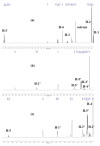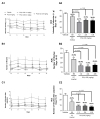Antinociceptive Effect of a p-Cymene/β-Cyclodextrin Inclusion Complex in a Murine Cancer Pain Model: Characterization Aided through a Docking Study
- PMID: 37298941
- PMCID: PMC10254339
- DOI: 10.3390/molecules28114465
Antinociceptive Effect of a p-Cymene/β-Cyclodextrin Inclusion Complex in a Murine Cancer Pain Model: Characterization Aided through a Docking Study
Abstract
Pain is one of the most prevalent and difficult to manage symptoms in cancer patients, and conventional drugs present a range of adverse reactions. The development of β-cyclodextrins (β-CD) complexes has been used to avoid physicochemical and pharmacological limitations due to the lipophilicity of compounds such as p-Cymene (PC), a monoterpene with antinociceptive effects. Our aim was to obtain, characterize, and measure the effect of the complex of p-cymene and β-cyclodextrin (PC/β-CD) in a cancer pain model. Initially, molecular docking was performed to predict the viability of complex formation. Afterward, PC/β-CD was obtained by slurry complexation, characterized by HPLC and NMR. Finally, PC/β-CD was tested in a Sarcoma 180 (S180)-induced pain model. Molecular docking indicated that the occurrence of interaction between PC and β-CD is favorable. PC/β-CD showed complexation efficiency of 82.61%, and NMR demonstrated PC complexation in the β-CD cavity. In the S180 cancer pain model, PC/β-CD significantly reduced the mechanical hyperalgesia, spontaneous nociception, and nociception induced by non-noxious palpation at the doses tested (p < 0.05) when compared to vehicle differently from free PC (p > 0.05). Therefore, the complexation of PC in β-CD was shown to improve the pharmacological effect of the drug as well as reducing the required dose.
Keywords: cancer pain; inclusion complex; monoterpenes; natural products.
Conflict of interest statement
The authors declare no conflict of interest.
Figures





Similar articles
-
Improvement of p-cymene antinociceptive and anti-inflammatory effects by inclusion in β-cyclodextrin.Phytomedicine. 2013 Mar 15;20(5):436-40. doi: 10.1016/j.phymed.2012.12.009. Epub 2013 Jan 26. Phytomedicine. 2013. PMID: 23357360
-
Docking, characterization and investigation of β-cyclodextrin complexed with citronellal, a monoterpene present in the essential oil of Cymbopogon species, as an anti-hyperalgesic agent in chronic muscle pain model.Phytomedicine. 2016 Aug 15;23(9):948-57. doi: 10.1016/j.phymed.2016.06.007. Epub 2016 Jun 11. Phytomedicine. 2016. PMID: 27387403
-
Physicochemical Characterization and Antinociceptive Effect of β-cyclodextrin/Lippia pedunculosa Essential Oil in Mice.Curr Top Med Chem. 2018;18(9):797-807. doi: 10.2174/1568026618666180607081742. Curr Top Med Chem. 2018. PMID: 29875002
-
Cyclodextrins: improving the therapeutic response of analgesic drugs: a patent review.Expert Opin Ther Pat. 2015;25(8):897-907. doi: 10.1517/13543776.2015.1045412. Epub 2015 May 10. Expert Opin Ther Pat. 2015. PMID: 25960079 Review.
-
Antinociceptive Activity of Chemical Components of Essential Oils That Involves Docking Studies: A Review.Front Pharmacol. 2020 May 29;11:777. doi: 10.3389/fphar.2020.00777. eCollection 2020. Front Pharmacol. 2020. PMID: 32547391 Free PMC article.
Cited by
-
Nigella sativa L. and its bioactive and nutraceutical components in the management of diabetic peripheral neuropathy.Inflammopharmacology. 2024 Oct;32(5):2897-2920. doi: 10.1007/s10787-024-01528-6. Epub 2024 Aug 14. Inflammopharmacology. 2024. PMID: 39143432 Review.
-
Therapeutic Potential of Myrtenal and Its Derivatives-A Review.Life (Basel). 2023 Oct 20;13(10):2086. doi: 10.3390/life13102086. Life (Basel). 2023. PMID: 37895468 Free PMC article. Review.
References
-
- Lara-Solares A., Ahumada Olea M., Basantes Pinos A.d.L.Á., Bistre Cohén S., Bonilla Sierra P., Duarte Juárez E.R., Símon Escudero O.A., Santacruz Escudero J.G., Flores Cantisani J.A. Latin-American Guidelines for Cancer Pain Management. Pain Manag. 2017;7:287–298. doi: 10.2217/pmt-2017-0006. - DOI - PubMed
MeSH terms
Substances
LinkOut - more resources
Full Text Sources
Medical

